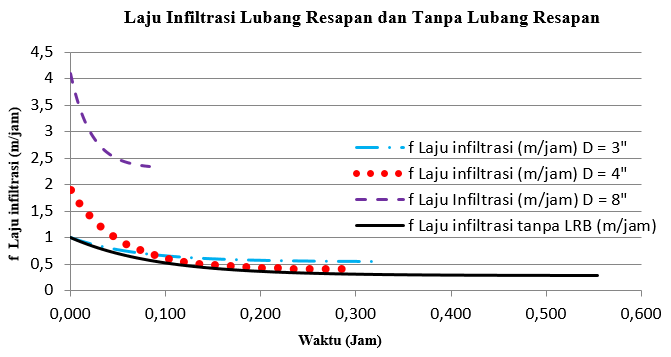Penerapan Model Horton Untuk Kuantifikasi Laju Infiltrasi
Application of the Horton Model for Quantification of Infiltration Rate
DOI:
https://doi.org/10.25299/saintis.2018.vol18(1).3198Keywords:
laju infiltrasi, limpasan air hujan, model HortonAbstract
[ID] Kapasitas infiltrasi akan semakin menurun bila bidang resapan air semakin berkurang. Dampaknya limpasan air hujan yang menjadi aliran permukaan akan semakin meningkat. Konsep perencanaan yang memperbesar air hujan meresap ke dalam tanah akan mampu mengurangi aliran permukaan. Penelitian ini bertujuan untuk kuantifikasi laju infiltrasi air hujan dengan menerapkan model Horton. Metode yang dilakukan adalah uji sampel di lapangan terhadap laju infiltrasi pada bidang tanah yang tidak ada lubang resapan dan bidang tanah yang diberi lubang resapan. Dimensi lubang resapan adalah diameter (Ø) 3 inchi, 4 inchi, dan 8 inchi dengan kedalaman 1,1 m menggunakan alat ukur double ring infiltrometer. Metode perhitungan menggunakan rumus infiltrasi Horton. Dapat disimpulkan bahwa lubang resapan berpengaruh terhadap peningkatkan laju infiltrasi air hujan ke dalam tanah, sehingga dapat meningkatkan daya resap air ke tanah. Laju infitrasi model Horton pada lubang resapan Ø 3 inchi, Ø 4 inchi, Ø 8 inchi dan tanpa lubang resapan adalah f (t) = 0,55+0,45e-14t ; f (t) = 0,4+1,5e-19,5 t ; f (t) = 2,3+1,8e-46t ; dan f (t) = 0,28+0,72e-10,7t. Nilai laju infiltrasi yang paling besar hingga paling kecil adalah f (0) = 4,1 m/jam (pada Ø 8 inchi); f (0) = 1,9 m/jam (pada Ø 4 inchi); f (0) = 1 m/jam (pada Ø 3 inchi); dan f (0) = 1 m/jam (tanpa lubang resapan). Perbandingan akumulasi waktu laju infiltrasi terhadap lubang resapan Ø 8 inchi adalah 3,8 kali lebih lambat (pada Ø 3 inchi), 3,6 kali lebih lambat (pada Ø 4 inchi), dan 6,63 kali lebih lambat (tanpa lubang resapan).
[EN] Infiltration capacity will decrease if the water absorption field decreases. The impact of rainwater runoff which becomes surface runoff will increase. The concept of planning that enlarges rainwater seeps into the ground will be able to reduce surface flow. This study aims to quantify the rate of infiltration of rainwater by applying the Horton model. The method used is a sample test in the field against the infiltration rate in the field of land where there are no infiltration holes and soils are given infiltration holes. The dimensions of infiltration holes are diameter (Ø) 3 inches, 4 inches, and 8 inches with a depth of 1.1 m using a double ring infiltrometer measuring instrument. Calculation method using Horton infiltration formula. It can be concluded that infiltration holes affect the rate of infiltration of rainwater into the soil, so that it can increase the absorption rate of water to the ground. Inflation rate of Horton model in infiltration hole Ø 3 inches, Ø 4 inches, Ø 8 inches and without infiltration hole is f (t) = 0.55 + 0.45e-14t; f (t) = 0.4 + 1.5e-19.5 t; f (t) = 2.3 + 1.8e-46t; and f (t) = 0.28 + 0.72e-10.7t. The value of the largest infiltration rate to the smallest is f (0) = 4.1 m / hour (at Ø 8 inches); f (0) = 1.9 m / hour (at Ø 4 inches); f (0) = 1 m / hour (at Ø 3 inches); and f (0) = 1 m / hour (without infiltration holes). Comparison of accumulated infiltration time to infiltration hole Ø 8 inches is 3.8 times slower (at Ø 3 inches), 3.6 times slower (at Ø 4 inches), and 6.63 times slower (without infiltration holes).
Downloads
References
Brata, Kamir R (2009) Artikel Lubang Resapan Biopori, Bogor.
Chow,Ven Te et al (1998) Applied Hydrology, International Edtion, McGraw Hill Book Company, New York.
Harto, Sri (1993) Analisis Hidrologi, PT Gramedia Pustaka Utama Anggota IKAPI, Jakarta.
Harto, Sri (2000) Hidrologi: Teori, Masalah, & Penyelesaian, Nafiri Offset, Yogyakarta.
Hillel, D (1998) Environmental Soil Physics, Academic Press, San Diego, CA.
Jain, Ashu et al (2006), An evaluation of artificial neural network technique for the determination of infiltration model parameters, Applied Soft Computing, 6, 272–282
Kundzewicz, Z.W et al (2007) Freshwater resources and their management. Cambridge University Press, Cambridge, UK, pp. 173–210.
Machiwal, Deepesh et al (2006) Modelling Infiltration and quantifying Spatial Soil Variability in a Wasteland of Kharagpur, India, Journal of Biosystems Engineering-Soil and Water, 95(4), 569–582.
Marthanty, Dwinanti R (2008) Uji Kelayakan Metode Infiltrasi Horton Sebagai Alternatif Perhitungan Limpasan Hujan Metode SCS, Tesis, Departemen Teknik Sipil Universitas Indonesia, Depok.
Peraturan Menteri Negara Lingkungan Hidup Nomor 12 Tahun 2009 Tentang Pemanfaatan Air Hujan.
Petit-Boix, Anna et al (2015) Environmental and economic assessment of a pilot stormwater infiltration system for flood prevention in Brazil, Ecological Engineering, 84, 194–201.
Rao, K.P.C. et al (1998) Rainfall infltration and runoff from an Alfsol in semi-arid tropical India. II. Tilled systems, Soil & Tillage Research, 48, 61-69.
Soemarto, CD (1995) Hidrologi Teknik, Erlangga, Jakarta.

Downloads
Published
Issue
Section
License

This work is licensed under a Creative Commons Attribution-ShareAlike 4.0 International License.
Copyright. This is an open access article which means that all content is freely available without charge to the user or his/her institution. Jurnal Saintis allows the author(s) to hold the copyright without restriction. The copyright in the text of individual articles (including research articles, opinion articles, and abstracts) is the property of their respective authors distributed under the terms of the Creative Commons Attribution-ShareAlike 4.0 International License which permits unrestricted use, distribution, and reproduction in any medium. Users are allowed to read, download, copy, distribute, search, or link to full-text articles in this journal without asking by giving appropriate credit, provide a link to the license, and indicate if changes were made.





